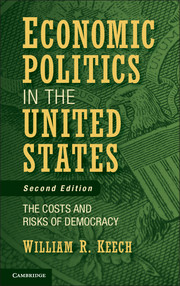Book contents
- Frontmatter
- Contents
- List of Figures and Tables
- Preface to the Second Edition
- Preface to the First Edition
- Part One Introduction
- Part Two Models of Macroeconomic Politics in a Democracy
- Part Three The Sources and Authority of Macroeconomic Goals
- Part Four Institutions and Processes
- Part Five Conclusion
- References
- Index
Part Four - Institutions and Processes
Published online by Cambridge University Press: 05 June 2014
- Frontmatter
- Contents
- List of Figures and Tables
- Preface to the Second Edition
- Preface to the First Edition
- Part One Introduction
- Part Two Models of Macroeconomic Politics in a Democracy
- Part Three The Sources and Authority of Macroeconomic Goals
- Part Four Institutions and Processes
- Part Five Conclusion
- References
- Index
Summary
This section treats the institutions and processes by which macroeconomic stabilization policy is made. Chapter 8 deals with political control of the money supply and interest rates, or monetary policy. Chapter 9 deals with the politics of taxing and spending, or fiscal policy. In both cases, the immediate pressures and demands of policy making take place in the context of an overall debate about rules versus discretion. Although policy makers are not always conscious of that overall debate, their actions may lean one way or the other. Until the recent financial crisis, I believe that monetary policy had moved in the direction of rule-based behavior since the 1980s, whereas fiscal policy had become increasingly discretionary and ad hoc.
In the period since World War II, there was a time when fiscal policy was seen as the main instrument of stabilization, but it has since been eclipsed by monetary policy. And for the period of the “Great Moderation” between about 1984 and 2007, it seemed that problems of stabilization policy had been resolved, that is, until the financial crisis of 2007 and after. Ad hoc fiscal policy has been used repeatedly in the twenty-first century, culminating in the massive stimulus bill passed in February 2009. Yet the standard view is and remains that “the central bank should and does have a dominant role in stabilization policy (Blinder 2006, p. 26, emphasis in original).
- Type
- Chapter
- Information
- Economic Politics in the United StatesThe Costs and Risks of Democracy, pp. 177 - 178Publisher: Cambridge University PressPrint publication year: 2013



